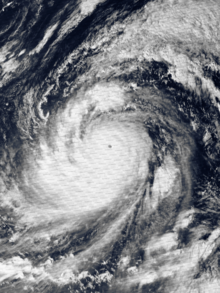
Back Tifó Tip Catalan Tajfun Tip Czech Taifun Tip German Tifón Tip Spanish Taifuuni Tip Finnish Typhon Tip French טייפון טיפ HE टाइफ़ून टिप Hindi Tip tájfun (1979) Hungarian Topan Tip ID
 Tip at its record peak intensity on October 12 | |
| Meteorological history | |
|---|---|
| Formed | October 4, 1979 |
| Extratropical | October 19, 1979 |
| Dissipated | October 24, 1979 |
| Violent typhoon | |
| 10-minute sustained (JMA) | |
| Highest winds | 260 km/h (160 mph) |
| Lowest pressure | 870 hPa (mbar); 25.69 inHg (Worldwide record low) |
| Category 5-equivalent super typhoon | |
| 1-minute sustained (SSHWS/JTWC) | |
| Highest winds | 305 km/h (190 mph) |
| Lowest pressure | 870 hPa (mbar); 25.69 inHg (Worldwide record low) |
| Overall effects | |
| Fatalities | 99 |
| Damage | $484 million (1979 USD) |
| Areas affected | Caroline Islands, Philippines, Korean Peninsula, Japan, Northeast China, Russian Far East, Alaska |
| IBTrACS | |
Part of the 1979 Pacific typhoon season | |
Typhoon Tip, known in the Philippines as Super Typhoon Warling, was the largest and most intense tropical cyclone ever recorded. The forty-third tropical depression, nineteenth tropical storm, twelfth typhoon, and third super typhoon of the 1979 Pacific typhoon season, Tip developed out of a disturbance within the monsoon trough on October 4 near Pohnpei in Micronesia. Initially, Tropical Storm Roger to the northwest hindered the development and motion of Tip, though after the storm tracked farther north, Tip was able to intensify. After passing Guam, Tip rapidly intensified and reached peak sustained winds of 305 km/h (190 mph)[nb 1] and a worldwide record-low sea-level pressure of 870 hPa (25.69 inHg) on October 12. At its peak intensity, Tip was the largest tropical cyclone on record, with a wind diameter of 2,220 km (1,380 mi). Tip slowly weakened as it continued west-northwestward and later turned to the northeast, in response to an approaching trough. The typhoon made landfall in southern Japan on October 19, and became an extratropical cyclone shortly thereafter. Tip's extratropical remnants continued moving east-northeastward, until they dissipated near the Aleutian Islands on October 24.
U.S. Air Force aircraft flew 60 weather reconnaissance missions into the typhoon, making Tip one of the most closely observed tropical cyclones.[1] Rainfall from Tip indirectly led to a fire that killed 13 Marines and injured 68 at Combined Arms Training Center, Camp Fuji in the Shizuoka Prefecture of Japan.[2] Elsewhere in the country, the typhoon caused widespread flooding and 42 deaths; offshore shipwrecks left 44 people killed or missing.
Cite error: There are <ref group=nb> tags on this page, but the references will not show without a {{reflist|group=nb}} template (see the help page).
- ^ George M. Dunnavan; John W. Dierks (1980). "An Analysis of Super Typhoon Tip (October 1979)". Monthly Weather Review. 108 (II). Joint Typhoon Warning Center: 1915–1923. Bibcode:1980MWRv..108.1915D. doi:10.1175/1520-0493(1980)108<1915:AAOSTT>2.0.CO;2. ISSN 1520-0493.
- ^ Little, Vince (2007-10-19). "Marines recall 1979 fire at Camp Fuji that claimed 13 lives". Stars and Stripes. Archived from the original on 2018-10-17. Retrieved 2016-07-25.
© MMXXIII Rich X Search. We shall prevail. All rights reserved. Rich X Search